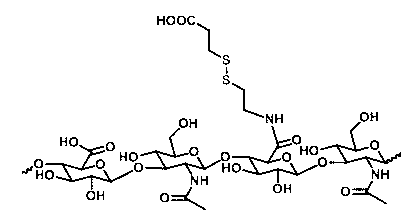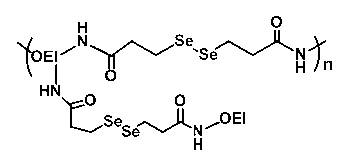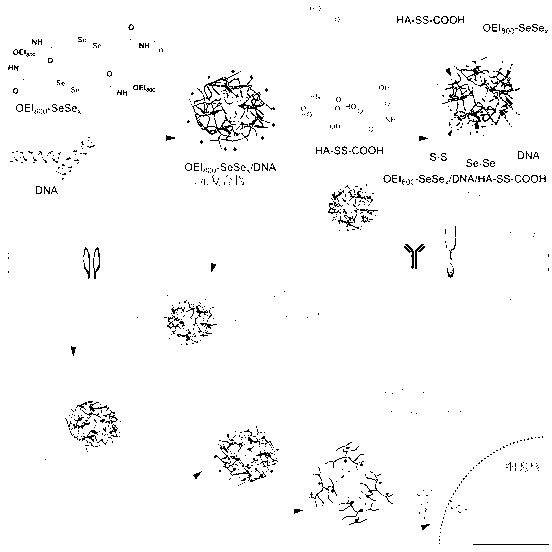Genetic vector system of nanoparticle with multiple oxidation-reduction stimulus response as well as preparation method and application of genetic vector system
A gene carrier and system technology, applied in the field of nanoparticle gene carrier, can solve the problems of low transfection efficiency, cytotoxicity, high surface positive charge, etc.
- Summary
- Abstract
- Description
- Claims
- Application Information
AI Technical Summary
Problems solved by technology
Method used
Image
Examples
Embodiment 1
[0061] Example 1: Preparation of gene carrier (OEI-SS / DNA / HA-SS-COOH) with double redox stimulus responsiveness
[0062] Dissolve the plasmid DNA in sterile HBG buffer (20 mmol of 4-hydroxyethylpiperazineethanesulfonic acid, 5% glucose) to prepare a DNA solution with a concentration of 0.1 mg / mL; Polyethylenimine (OEI-SS) was dissolved in HBG buffer to prepare OEI-SS solution with a concentration of 0.1-10 mg / mL; the masking system containing disulfide bonds (HA-SS-COOH) was dissolved in HBG HA-SS-COOH solution with a concentration of 0.01-1 mg / mL in the buffer solution.
[0063] The above OEI-SS solution and the plasmid DNA solution were mixed, and the mixed solution was incubated at room temperature for 20 minutes to obtain the OEI-SS / DNA binary complex. Then add HA-SS-COOH solution, and incubate the resulting mixed solution at room temperature for 20 minutes to obtain the gene carrier OEI-SS / DNA / HA- SS-COOH ternary complex.
Embodiment 2
[0064] Example 2: Gene carrier with dual redox stimulus responsiveness (OEI-SeSe x / DNA / HA-SeSe-COOH) preparation
[0065] Dissolve the plasmid DNA in sterile HBG buffer (20 mmol of 4-hydroxyethylpiperazineethanesulfonic acid, 5% glucose) to prepare a DNA solution with a concentration of 0.1 mg / mL; Polyethyleneimine (OEI-SeSe x ) was dissolved in HBG buffer to prepare OEI-SeSe at a concentration of 0.1-10 mg / mL x Solution: Dissolve the shielding system (HA-SeSe-COOH) containing diselenium bonds in HBG buffer to prepare a HA-SeSe-COOH solution with a concentration of 0.01-1 mg / mL.
[0066] The above OEI-SeSe x The solution solution and the plasmid DNA solution were mixed, and the mixed solution was incubated at room temperature for 20 minutes to obtain OEI-SeSe x / DNA binary complex. After adding HA-SeSe-COOH solution, the resulting mixed solution was incubated at room temperature for 20 minutes, and the gene carrier OEI-SeSe with multiple redox stimulus responsiveness c...
Embodiment 3
[0067] Example 3: Gene carrier with dual redox stimulus responsiveness (OEI-SeSe x / DNA / HA-SS-COOH) preparation
[0068] Dissolve the plasmid DNA in sterile HBG buffer (20 mmol of 4-hydroxyethylpiperazineethanesulfonic acid, 5% glucose) to prepare a DNA solution with a concentration of 0.1 mg / mL; Polyethyleneimine (OEI-SeSe x ) was dissolved in HBG buffer to prepare OEI-SeSe at a concentration of 0.1-10 mg / mL x Solution: Dissolve the shielding system (HA-SS-COOH) containing disulfide bonds in HBG buffer to prepare a HA-SS-COOH solution with a concentration of 0.01-1 mg / mL.
[0069] The above OEI-SeSe x The solution solution and the plasmid DNA solution were mixed, and the mixed solution was incubated at room temperature for 20 minutes to obtain OEI-SeSe x / DNA binary complex. After adding HA-SS-COOH solution, the resulting mixed solution was incubated at room temperature for 20 minutes, and the gene carrier OEI-SeSe with multiple redox stimulus responsiveness was obtain...
PUM
| Property | Measurement | Unit |
|---|---|---|
| molecular weight | aaaaa | aaaaa |
| surface potential | aaaaa | aaaaa |
| molecular weight | aaaaa | aaaaa |
Abstract
Description
Claims
Application Information
 Login to View More
Login to View More - R&D
- Intellectual Property
- Life Sciences
- Materials
- Tech Scout
- Unparalleled Data Quality
- Higher Quality Content
- 60% Fewer Hallucinations
Browse by: Latest US Patents, China's latest patents, Technical Efficacy Thesaurus, Application Domain, Technology Topic, Popular Technical Reports.
© 2025 PatSnap. All rights reserved.Legal|Privacy policy|Modern Slavery Act Transparency Statement|Sitemap|About US| Contact US: help@patsnap.com



